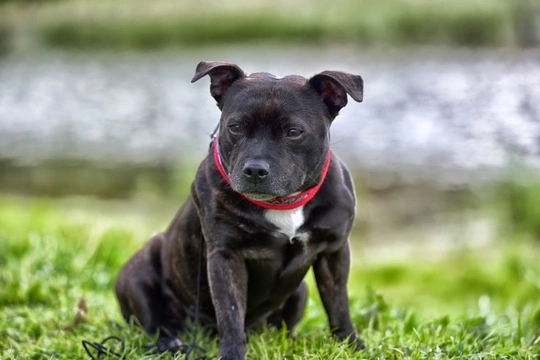
Skin problems in the Staffordshire Bull Terrier
The Staffordshire bull terrier or “Staffy” for short is one of the most popular dog breeds in the UK, and these loving, loyal companions make for a great choice of pet for people from all walks of life.
The breed as a whole is one that tends to be robust and healthy and not prone to picking up minor ills and ailments – but like all dog breeds, there are a range of health problems and hereditary issues that are rather more prevalent within the breed than others, which all potential Staffy buyers should be aware of.
One of the breed’s distinctive features is their short, single-layered fur, which makes their coats low maintenance and easy to look after, but can mean that Staffordshire bull terriers will be apt to feel the cold somewhat during the cooler months of the year. Additionally, some dogs of the breed seem to suffer from more than their fair share of skin and coat problems, which we will look at in more detail within this article.
Read on to learn more about some of the more common skin and coat problems that can arise in the Staffordshire bull terrier dog breed.
Atopic dermatitis
Atopic dermatitis is a chronic skin problem that usually recurs at various points in the dog’s life, and leads to irritation, inflammation, and itching of the skin. This is likely to make your Staffy feel rather uncomfortable, and lead to a lot of scratching, licking and bothering at their skin in the dog’s attempts to get some relief from the irritation.
Atopic dermatitis is a type of allergic reaction that manifests in topical, skin-based symptoms, and that can make your dog quite miserable. In order to resolve the issue, you will need to work with your vet to control the symptoms and their impact on your dog and if possible, determine the allergenic trigger itself and eradicate it.
Hot spots
Hot spots develop in localised areas on the skin, and take the form of sore, red and irritated spots or patches on the skin that may be individual or in clusters. Generally, something irritating the skin in a certain spot will cause your dog to lick, scratch and bother at the area until redness and soreness ensues, which may also lead to loss of fur over the area in question, and can lead to secondary infections developing due to the damage caused to the skin.
Bald spots
All dogs shed hair throughout the year, even those with very short hair – and they will usually shed more heavily a couple of times a year when the seasons change too. However, normal shedding shouldn’t result in bald spots or sparse areas on your dog’s coat, and bald patches can be caused by a variety of different issues.
If your dog has fleas or mites, they are apt to rub and scratch to gain relief, which can in turn lead to localised areas of baldness. Alopecia can also lead to hair loss, as can certain hormonal conditions.
Skin infections
Staffordshire bull terriers actually have fairly sensitive skin, which can mean that you will have to choose their shampoo and grooming products carefully. The breed is also rather sensitive to developing skin infections as a result of overgrooming, hot spots, and irritations.
Dandruff
Dandruff can afflict dogs just as it can people, and this is often particularly evident in breeds with short, fine fur, as you can comb down to the skin easily and see the level of congestion of shed skin cells and white flakes clearly.
A whole host of different root causes can lead to dandruff in Staffys, which sometimes, means that their skin is overly dry. Central heating and dry air can all cause dandruff in Staffordshire bull terriers with sensitive skin, as can stress – and using overly harsh shampoos, or overbathing your dog.
Allergies
Atopic dermatitis, as we mentioned earlier on, is an allergic skin condition that generally occurs due to topical or environmental allergens. However, Staffordshire bull terriers, like other dogs, can suffer from allergies of other types too, which some Staffys seem to be particularly susceptible to.
Contact allergens and pollen can all produce skin symptoms as well as potentially causing a runny nose and sore eyes, and if your Staffy has a food allergy or sensitivity, this is apt to cause digestive upsets and potentially, skin-related symptoms too.
Flea bite hypersensitivity is another potential allergy that Staffordshire bull terriers can develop if they are not treated with an appropriate effective flea treatment product regularly, which causes an extreme localised reaction anywhere your dog is bitten by a flea, which will be very itchy and sore too.
Once a dog has developed a sensitivity to flea bites, they will continue to react badly to bites in the future – and so preventing the condition from developing in the first place and being vigilant about eradicating and preventing fleas is vital.



